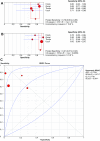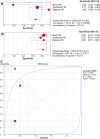Diagnostic accuracy of novel serological biomarkers to detect acute mesenteric ischemia: a systematic review and meta-analysis
- PMID: 28478489
- PMCID: PMC5559578
- DOI: 10.1007/s11739-017-1668-y
Diagnostic accuracy of novel serological biomarkers to detect acute mesenteric ischemia: a systematic review and meta-analysis
Abstract
Laparotomy remains the gold standard for diagnosis of acute mesenteric ischemia (AMI), but is often unhelpful or too late due to non-specific clinical and radiological signs. This systematic review and meta-analysis aims to evaluate the diagnostic accuracy of the novel serological biomarkers intestinal fatty acid-binding protein (I-FABP), α-glutathione S-transferase (α-GST), D-lactate, ischemia modified albumin (IMA), and citrulline to detect AMI. A systematic search of electronic databases was performed to identify all published diagnostic accuracy studies on I-FABP, α-GST, D-lactate, IMA, and citrulline. Articles were selected based on pre-defined inclusion and exclusion criteria. Risk of bias and applicability were assessed. Two-by-two contingency tables were constructed to calculate accuracy standards. Summary estimates were computed using random-effects models. The search yielded 1925 papers, 21 were included in the final analysis. Pooled sensitivity and specificity for investigated biomarkers were: I-FABP (Uden); 79.0 (95% CI 66.5-88.5) and 91.3 (87.0-94.6), I-FABP (Osaka); 75.0 (67.9-81.2) and 79.2 (76.2-82.0), D-lactate; 71.7 (58.6-82.5) and 74.2 (69.0-79.0), α-GST; 67.8 (54.2-79.5) and 84.2 (75.3-90.9), IMA; 94.7 (74.0-99.9) and 86.4 (65.1-97.1), respectively. One study investigated accuracy standards for citrulline: sensitivity 39% and specificity 100%. The novel serological biomarkers I-FABP, α-GST, IMA, and citrulline may offer improved diagnostic accuracy of acute mesenteric ischemia; however, further research is required to specify threshold values and accuracy standards for different aetiological forms.
Keywords: Acute abdomen; Acute mesenteric ischemia; Biomarker; Citrulline; D-Lactate; Diagnostic accuracy; Glutathione S-transferases; Intestinal fatty acid-binding protein; Ischemia modified albumin; Non-occlusive mesenteric ischemia.
Conflict of interest statement
Conflict of interest
The authors declare they have no conflict of interests.
Statement of human and animal rights
This article does not contain any studies with human participants or animals performed by any of the authors.
Informed consent
None.
Figures






References
-
- Martin B. Prevention of gastrointestinal complications in the critically ill patient. Can Adv Crit Care. 2007;18:158–166. - PubMed
Publication types
MeSH terms
Substances
LinkOut - more resources
Full Text Sources
Other Literature Sources
Research Materials

